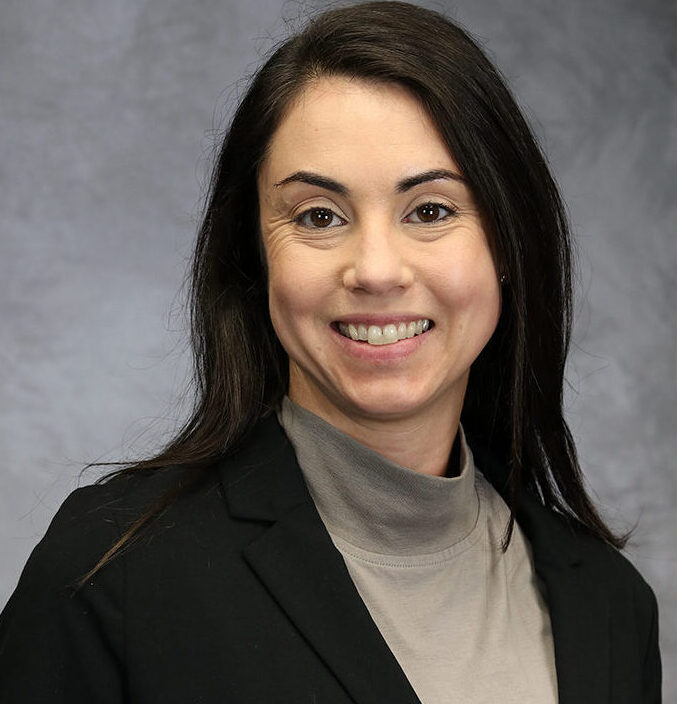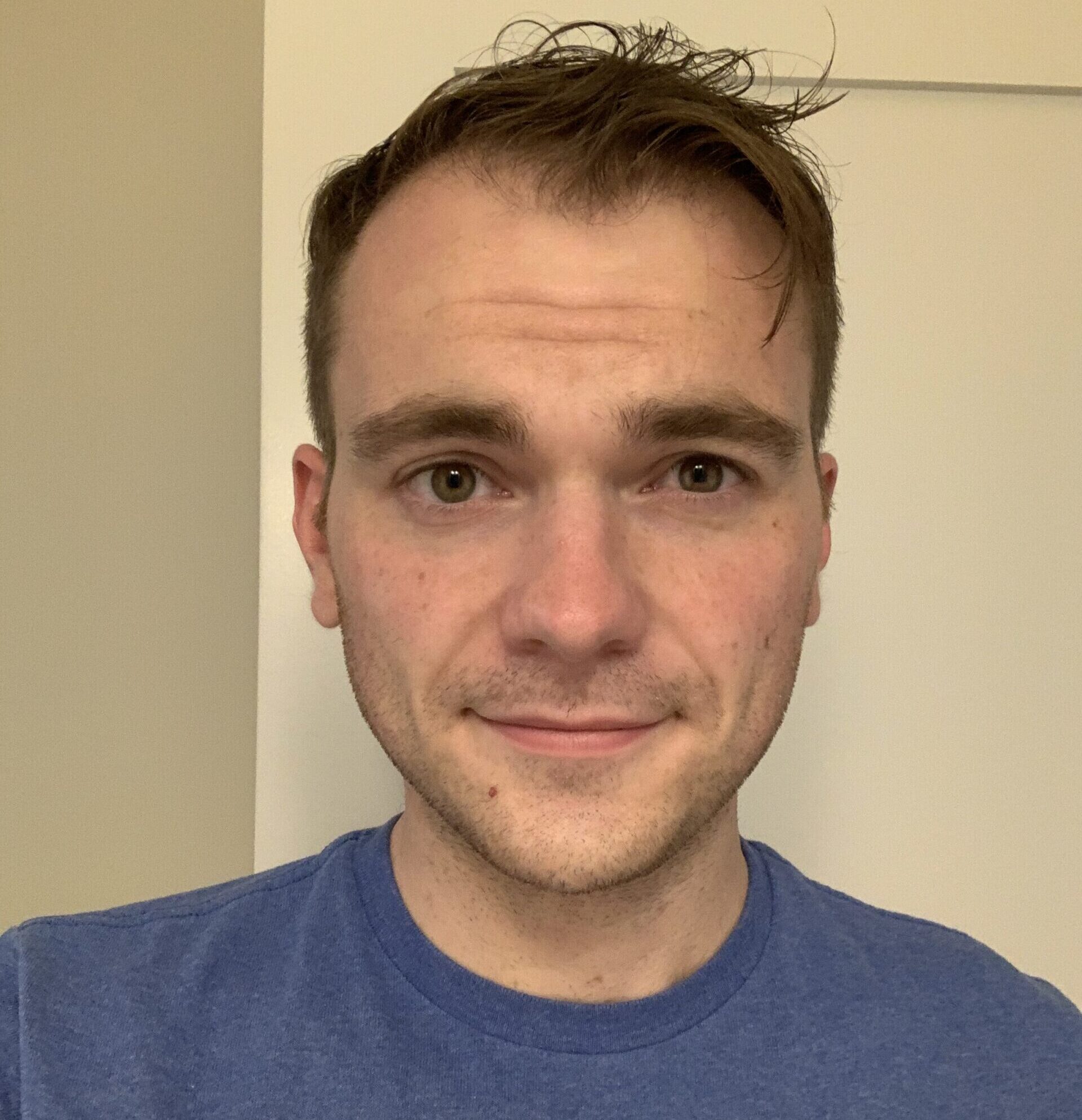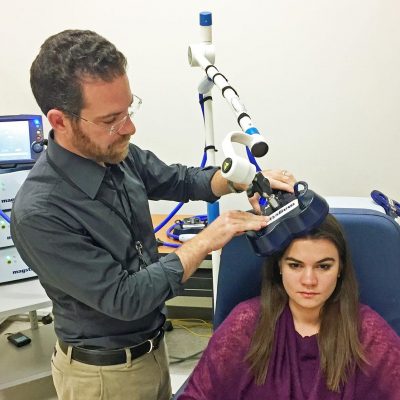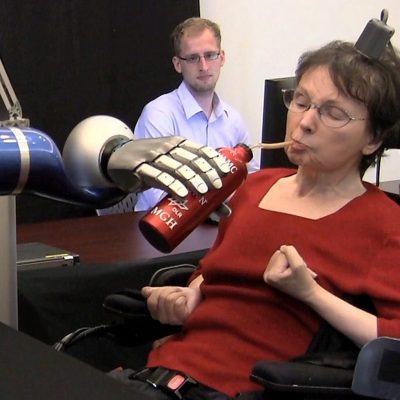The CfNN Focus Area: Research in Restoring Limb and Sensory function aims to advance rehabilitation, and develop and investigate new technologies for individuals with amputation and spinal cord injury (SCI). FA3 investigators have expertise in physical therapy, prosthetics, and outcomes measures as well as device and closed-loop engineering. Our investigations on restoring limb and sensory function provide new hope to Veterans and other persons with mobility limitations. FA3 investigators collaborate with clinicians and investigators across the United States with the goal of developing, evaluating, and deploying new techniques, therapies, and devices for restoration of limb, sensory and autonomic function.
Technology for persons with spinal cord injury
Spinal cord injuries (SCI) are estimated to affect between 249,000 and 363,000 Americans, and roughly 42,000 people with SCI are Veterans. Dr. David Borton, leads FA3 work devoted to improving function for persons with SCI. Dr. Borton is PI of the Intelligent Spine Interface (ISI) clinical trial aimed at restoring limb movement, sensation and bladder control in individuals who have suffered spinal cord injuries. The ISI-C project is working to design a brain-spine interface that can help to restore walking in those with lower limb paralysis. This project uses a novel surgical approach to implant 2 epidural spinal cord arrays for recording and stimulating. We then use modern neural network architectures to design stimulation protocols to restore motor and sensory function following a complete spinal cord injury. In our upcoming project aimed at developing a hardware and software accelerator platform or xDev, we would enable new research into spinal cord stimulation for sensorimotor restoration in SCI, as well as for continued investigation of spinal devices used for chronic pain. Our goal is to design a benchtop hardware sandbox in which future closed-loop neural prosthesis can be rapidly prototyped. We enable this through flexible, real-time, modular connections between components of various stages of development: from chip to clinically available. Leveraging the xDev platform, we will demonstrate a new neurotechnology enabling chronic recording of spinal electrophysiology and fill a neuroscientific knowledge gap, connecting the fields of Restorative Neurology and therapeutic spinal cord neuromodulation.

Some Restoring Limb and Sensory Function Related Research Projects:
- Design and Evaluation of Upper Limb Prosthetic Devices
- Dr. Resnik has been evaluating new upper limb prosthetic technology for over a decade. She was Principal Investigator of the multi-site VA Study to Optimize the DEKA Arm (VA RR&D A6780I) and VA Home Study of an Advanced Upper Limb Prosthesis (VA RR&D A9226-R). Data from the Optimization study was used to support FDA approval of the device (now called the LUKE Arm). The overall objective of the home study was to examine the feasibility, acceptance and benefits of home use of an advanced upper limb prosthetic device as well as the logistical support requirements utilized during three months of home usage. Data from that study, including prescription and training recommendations, repairs data, and guidelines for best practices have been broadly disseminated to programmatic partners to facilitate the clinical implementation of the DEKA Arm, which received FDA approval in 2014. The home study renewal (VA RR&D A077-R) aimed to compare the outcomes of users of EMG pattern recognition (PR) to the outcomes of users without. Her studies of the DEKA Arm have also evaluated socket suspension methods and included kinematic analyses comparing the DEKA Arm to conventional control. Dr. Resnik participated in the VA-DoD LUKE Arm transition Workgroup, which paved the way for the device’s clinical translation. The first two Veterans’ received the LUKE Arm in 2017 https://www.darpa.mil/news-events/2017-06-30 and the VA-DoD now has a clinical protocol, largely based on research evidence and training protocols from this research.
- Dr. Resnik collaborated on study design and analysis of data from the first home trials of a neural connected sensory prosthesis study (Tyler, DARPA N66001-15-C-4014). Currently, she is a Co-Investigator of a randomized clinical trial examining whether use of a sensory-enabled, high degree-of-freedom prosthesis with the iSens system, improves quality of life compared to use of a state-of-art prosthesis (Tyler, VA RR&D A3355-R). She also collaborated with researchers at North Carolina State to compare EMG-PR to conventional dual site EMG control of a 2 degree of freedom prosthesis. In collaboration with colleagues at Yale University, Resnik worked to develop a taxonomy for upper limb prosthesis grasps, geared towards improving device design.
National Study of Needs and Preferences of Veterans and Service Members with Upper Limb Amputation
- Dr. Resnik is the Principal Investigator of a national study of Veterans and service members with upper limb amputations. This study is funded by the DoD with supplemental funds from VA RR&D. The first DoD study was a collaborative effort involving partners from the University of Massachusetts Medical School, four VA Medical Centers, and a DoD site. The primary aims of this work are to: describe patterns of prosthesis use; identify the impact of amputation and prosthesis use on function, activities and participation; identify unmet prosthetic needs; and compare the effectiveness of different prosthesis types. Findings will also be compared for male and female amputees. The study included a one year longitudinal follow-up survey to examine changes in satisfaction with care and prosthetic services, physical performance, self-reported quality of life and physical function to assess the implementation of new clinical guidelines. The study also included an in-person assessment to quantify physical function using a battery of performance-based tests. The study has completed baseline surveys of over 800 Veterans, conducted 585 one year follow-up surveys of these participants and completed 127 in-person assessments of Veterans and community members. Many papers have been published reporting on the baseline and longitudinal survey findings. The in-person data has been used to generate normative values for dexterity and activity performance by amputation level and prosthesis type.
- A second DoD study, Comparative Effectiveness of Upper Limb Prostheses and Component Effects, will add approximately 200 persons to the in-person assessment sample from the study described above which will allow more robust comparisons of the effectiveness of upper limb prostheses and components. Recruitment and data collection for this study is ongoing. The following VA and DoD sites are recruiting participants:
- VA Tampa Healthcare Center (Tampa, FL)
- U.S. Army Institute of Surgical Research Burn Center (San Antonio, TX)
- VA Richmond Healthcare Center (Richmond, VA)
Funding for these studies has come from the DoD (OPORP W81XWH-16-2-0065, W81XWH-19-1-0800) and the VA (VA RR&D A2707-I).
Outcome Measurement for Persons with Amputation
Dr. Resnik is PI of a VA funded Merit Review, titled Advancing measurement of physical function in upper limb amputation (VA RR&D A4775-R). The long-term goal of this research is to provide clinicians and researchers with tools to evaluate and address the needs of women and men with upper limb amputation (ULA). The rationale for this proposal is that valid, reliable, and responsive measures of physical function (PF) are needed to detect disparities by sex, accurately track function over time, and discern effects of prosthesis characteristics and prosthesis training. The overall aim of this proposal is to advance the measurement of PF in ULA by refining two measures previously developed by Resnik’s research team: 1) the Upper Extremity Functional Scale for Prosthesis Users (UEFS-P), and 2) a custom 13-item version of the Patient-Reported Outcomes Measurement Information System (PROMIS). This study will advance state-of-the-art measurement of PF in ULA and provide translational tools to expedite measure adoption, ultimately driving improvements in care quality and research design.
- In a completed study, screening data was collected on over 120 upper limb amputees; enabling comparison of dexterity and activity performance by amputation level for conventional prosthesis users and providing critically needed data on the reliability and validity of commonly used measures. Screening and testing data enabled the team to advance the field of outcome assessment in upper limb amputation leading the development of several new outcome measures for upper limb amputation including the: Activities Measure for Upper Limb Amputees (AM-ULA), the Brief Activities Measure for Upper Limb Amputees (BAM-ULA), and the Timed Based Measurement of Activity Performance (T-MAP)). A form for collecting AM-ULA data, a list of frequently asked questions with answers, and the AM-ULA instruction guide are here. Data from this study was also used to examine the measurement properties of the commonly used Southampton Hand Assessment Test (SHAP). This work resulted in a briefer, reliable and valid version of the SHAP Index of Functionality (IOF), called the Prosthesis Index of Functionality (P-IOF) 1. Use of the P-IOF, rather than IOF would reduce administrative burden of this test by about 10 minutes. The P-IOF data collection form is available here. The scoring algorithm is available upon request.
-
Dr. Resnik’s VA RR&D Merit Review funded project, Validation of Patient Reported Outcomes for Female Veterans with Upper Limb Amputation (VA RR&D A2936-R) was a measurement development and refinement study that collected data from 742 persons with upper limb amputation including 153 women. This study resulted in numerous revised and novel measures as described below. All measures and scoring algorithms are available upon request.
The OPUS CSD-W, a prosthesis satisfaction measure, based on the OPUS Client Satisfaction with Device (CSD) scale, that incorporates issues of concern to women with upper limb amputation. 2 The measure has three subscales: Comfort, Appearance, and Utility
A revised TAPES Psychosocial Adjustment scale,3 to enable administration to both prosthesis users and non-users. The revised measure consists of two scales: Adjustment to Limitations and Work and Independence.
A modified PEQ residual limb health scale, which is valid and reliable for persons with upper limb amputation.4
The Patient Experience Measure (PEM), designed to be responsive to impacts of sensory enabled prostheses. The six subscales of the PEM address social interaction, self-efficacy, embodiment, intuitiveness, wellbeing and self-consciousness,5 and device affordability,6 and prosthesis acceptance.7
The Prosthesis Usability Experience Measures include five subscales on Prosthesis Comfort, Prosthesis Trust, Appearance Acceptability, Prosthesis Desirability and Prosthesis Ease of Use.
The Prosthesis Affordability Scale is the first of its kind, reliable and valid measure of prosthesis affordability persons with upper limb amputation.6 The scale has unique content that is not covered by prosthesis satisfaction measures and has applicability to health economic assessments.
Self-reported physical function. Dr. Resnik has advanced the measurement of self-reported activity limitations in upper limb amputation. She examined several short form versions of the PROMIS Upper Extremity scale (PROMIS-UE SF) and developed a unique version with prosthesis specific calibration (PROMIS-UE).8 Additionally, she developed modified version of the OPUS Upper Extremity Function Scale (UEFS) that is specific to prosthesis users, the UEFS-P, which consists of a One-handed Task scale and a Two-Handed Task Scale.9 Dr. Resnik’s newest Merit Review, Advancing measurement of physical function in upper limb amputation (VA RR&D RX004775-01) will expand on this body of work to refine the UEFS-P and PROMIS UE-SF measures and develop a toolkit for implementation into clinical practice.
- Development, Evaluation and Deployment of Rehabilitation Outcomes Measures
- Dr. Resnik is the developer of the Community Reintegration of Injured Service Members Scale (CRIS) and the CRIS-CAT – a computer adaptive test version of the measure. The CRIS-CAT is available here at Github. These measures use the conceptual framework of “participation” as described by the WHO’s International Classification of Functioning, Disability and Health. Dr. Resnik also served as chairperson of the VA RR&D’s Community Reintegration Working Group.
FA 3 Co-investigator:
- David Borton, PhD, VA Providence Healthcare System
FA 3 Collaborators:
- Liza Aguiar, MD, Rhode Island Hospital
- Ellie Balakhanlou, MD – Virginia Commonwealth University
- Ethan Balk, MD, PhD – VA Providence Healthcare System, Brown University, Providence, RI
- Jessica Barth, OT PhD, VA Providence Healthcare System
- Jill Cancio, OTD, OTR/L – U.S. Army Institute of Surgical Research Burn Center, San Antonio, TX
- Alexios Caravannopoulos, DO, Rhode Island Hospital
- Melissa Clark, PhD – Brown University, Providence, RI
- Jared Fridley, MD, Rhode Island Hospital
- Ziya Gokaslan, MD, Rhode Island Hospital
- Emily Graczyk, PhD – Case Western Reserve University; Louis Stokes Cleveland VA
- Jeffrey Heckman, DO – James A. Haley VA, Tampa, FL
- Allen Heinemann, PhD, Shirley Ryan Ability Laboratory, Feinberg School of Medicine, Northwestern University, Chacago, IL
- John Hermansen, MD – Central Virginia Veterans Healthcare System
- M. Jason Highsmith, PhD, PT – University of South Florida, Tampa, FL; U.S. Dept. of Veterans Affairs, Washington, DC
- Leigh Hochberg, MD, VA Providence Healthcare System
- David Lin, MD – VA Providence Healthcare System, Massachusetts General Hospital
- Nicole McLaughlin, Butler Hospital
- Adetokunbo Oyelese, MD, Rhode Island Hospital
- Samuel Phillips, PhD – James A. Haley VA, Tampa, FL
- Pengsheng Ni, PhD – Boston University, Boston, MA
- Anthony Roberts, MS – Brown University
- Jacob Segil, PhD, VA Providence Healthcare System
- Ryan Solinsky, MD, Mayo Clinic
- Phil Stevens, MEd, CPO/FAAOP, Hanger Clinic, Salt lake City, Utah
- Jennifer Sullivan, PhD, VA Healthcare System
- Dustin Tyler, PhD – Case Western Reserve University; Louis Stokes Cleveland VA
- Joseph Webster, MD – Hunter Holmes McGuire VA, Richmond, VA
- Oksana Witt, MD – Hunter Holmes McGuire VA, Richmond, VA
References
- Resnik L, Borgia M, Cancio JM, Delikat J, Ni P. Psychometric evaluation of the Southampton hand assessment procedure (SHAP) in a sample of upper limb prosthesis users. J Hand Ther. Aug 13 2021;doi:10.1016/j.jht.2021.07.003
- Resnik LJ, Borgia ML, Clark MA, Heinemann AW, Ni P. Measuring Satisfaction With Upper Limb Prostheses: Orthotics and Prosthetics User Survey Revision That Includes Issues of Concern to Women. Arch Phys Med Rehabil. Jun 12 2022;doi:10.1016/j.apmr.2022.05.008
- Resnik L, Borgia M, Ni P, Clark M. Psychosocial Adjustment Measure for Persons with Upper Limb Amputation. Canadian Journal of Prosthetics and Orthotics. Canadian Journal of Prosthetics and Orthotics. 2022;5(1)doi: https://doi.org/10.33137/cpoj.v5i1.37873
- Resnik L, Borgia M, Clark M, Ni P. Structural Validity and Reliability of the PEQ Residual Limb Health Scale in Persons with Upper Limb Amputation. Prosthet Orthot Int. 2021;published online ahead of printdoi:doi:10.1097/PXR.0000000000000227
- Resnik LJ, Borgia ML, Clark MA, Graczyk E, Segil J, Ni P. Structural validity and reliability of the patient experience measure: A new approach to assessing psychosocial experience of upper limb prosthesis users. PLoS One. 2021;16(12):e0261865. doi:10.1371/journal.pone.0261865
- Resnik L, Borgia M, Clark M, Ni P. Out-of-pocket costs and affordability of upper limb prostheses. [published online ahead of print, 2023 Mar 9]. Prosthet Orthot Int. 2023;10.1097/PXR.0000000000000223. doi:10.1097/PXR.0000000000000223
- Schmidt, C, Borgia, M, Zhang, T, Shireman, T, Resnik, L. Initial Treatment Approaches and Healthcare Utilization among Veterans with Low Back Pain, BMC Health Serv Res. 2023;23(1):275. Published 2023 Mar 21. doi:10.1186/s12913-023-09207-y
- Webster J, Borgia M, Resnik L. Prosthesis nonuse and discontinuation in United States veterans with major limb amputation: Results of a national survey [published online ahead of print, 2023 Jun 13]. Prosthet Orthot Int. 2023;10.1097/PXR.0000000000000248. doi:10.1097/PXR.0000000000000248
- Witt, O, Borgia, M, Resnik, L, Webster, J. Outcomes Associated with Concomitant Lower Limb Amputation in Persons with Major Upper Limb Amputation: Results of a National Study, Journal of Prosthet Orthot Int: 10.1097/JPO.0000000000000480, August 7, 2023. | DOI: 10.1097/JPO.0000000000000480
- Resnik L, Borgia M, Heinemann A, Stevens P, Clark M, Ni P. The Upper Extremity Functional Scale for Prosthesis Users (UEFS-P): subscales for one and two-handed tasks. Disabil Rehabil. 2023 Nov;45(22):3768-3778. doi: 10.1080/09638288.2022.2138572. Epub 2022 Nov 10. PMID: 36357971.
- Resnik L, Borgia M, Clark MA, Ni P. Measuring residual limb health in persons with upper limb amputation: Modifications of the Prosthetic Evaluation Questionnaire residual limb health scale. Prosthet Orthot Int. 2023 Oct 1;47(5):544-551. doi: 10.1097/PXR.0000000000000227. Epub 2023 Mar 9. PubMed PMID: 36897201.
- Schmidt, C, Borgia, M, Zhang, T, Shireman, T, Resnik, L. Initial Treatment Approaches and Healthcare Utilization among Veterans with Low Back Pain, BMC Health Serv Res. 2023;23(1):275. Published 2023 Mar 21. doi:10.1186/s12913-023-09207-y
- Kohler F, Halford GRJ, Lukin M, et al. Categorization and recommendations for outcome measures for lower limb absence by an expert panel. Prosthet Orthot Int. Published online October 16, 2023. doi:10.1097/PXR.0000000000000307
- Resnik LJ, Borgia ML, Clark MA. Prevalence and predictors of unmet need for upper limb prostheses: An observational cohort study. J Prosthet Orthot. 2023;2023:10.1097/JPO.0000000000000477. doi:10.1097/JPO.0000000000000477
- Resnik LJ, Stevens PM, Ni P, Borgia ML, Clark MA. Assessment of Patient-Reported Physical Function in Persons with Upper Extremity Amputation: Comparison of Short Form instruments drawn from the PROMIS v2.0 Upper Extremity item bank. Am J Phys Med Rehabil. 2023;102(2):120-129;doi:10.1097/PHM.0000000000002044
- Resnik LB, M., Gracyzk E, Barth J, Ni P. Predictors of Extent of Upper Limb Prosthesis Adoption: A Structural Equation Modeling Analysis, Disability and Rehabilitation. PLOS One, In Press, February 2024








